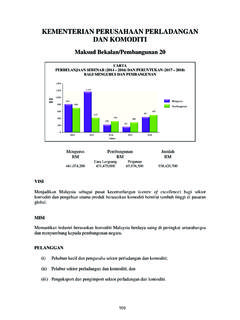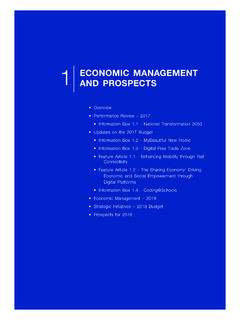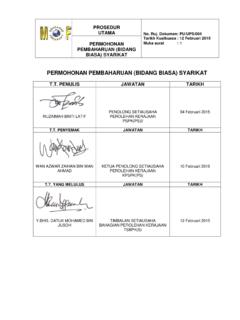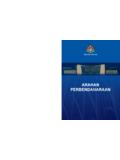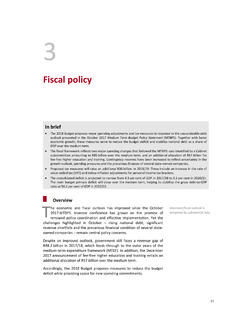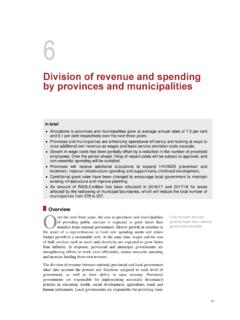Transcription of 4 FINANCE PUBLIC SECTOR - Kementerian …
1 PUBLIC SECTORFINANCE4 Overview Federal Government Information Box - Update on the Implementation of Goods and Services Tax External Debt PUBLIC SECTOR Debt Feature Article - Government Guarantees: Catalysing Economic Growth State Governments General Government Non-Financial PUBLIC Corporations Consolidated PUBLIC SECTOR ProspectsChapter 7710/20/17 10:17 PMChapter 7810/20/17 10:17 PM79 ECONOMIC REPORT 2017/18 PUBLIC SECTOR FINANCE4 OverviewPro-growth fiscal consolidationThe Government has embarked on the PUBLIC FINANCE Reform Initiative under the Fiscal Transformation Programme to further strengthen the Government s fiscal position.
2 A number of initiatives have been implemented including enhancing tax administration and compliance; expenditure rationalisation and optimisation; improving fiscal policy institution; as well as strengthening budget management and control. The fiscal policy is anchored on three main objectives, namely to ensure economic stability through counter-cyclical measures, promote conducive business environment and enhance inclusivity. Over the period, the Government has gradually reduced its fiscal deficit as a percentage of GDP from in 2009 to in 2016. The fiscal policy continues to emphasise on fiscal consolidation path while at the same time assuring a sound macroeconomic environment to support private SECTOR activity.
3 The Malaysian economy recorded a higher-than-expected growth in the first half of 2017, reflecting the pro-growth fiscal consolidation initiatives. For the year, the Government continues to leverage on its fiscal policy instruments through revenue and expenditure measures to create fiscal space and achieve macroeconomic goals. Total revenue collection for 2017 is estimated to record a growth of in line with expected higher tax revenue, mainly from companies and individual income taxes, reflecting continued expansion in economic activity as well as stable commodity prices.
4 Similarly, non-tax revenue is expected to record a higher collection contributed partly by divestment activity signifying Government s effort to gradually reduce its direct involvement in the market. Overall, the tax policy remains an effective fiscal instrument to generate sustainable revenue, support business activity and promote domestic the expenditure side, the Government remains committed to implement optimisation measures to enhance spending efficiency, and prioritise rakyat-centric and high impact programmes. This is to ensure fiscal consolidation is on track and supports the economic growth momentum without compromising PUBLIC service delivery.
5 In addition, expenditure is geared towards maximising outcome, reducing leakages and enhancing value for money. Nevertheless, the Government continues to provide essential services, particularly health and education, and targeted social assistance to ensure the wellbeing of the this regard, the thrust of fiscal policy will be further strengthened over the medium-term. The formulation of Medium-Term Fiscal Framework (MTFF) acts as the principal planning mechanism to drive fiscal consolidation efforts. Under the framework, the deficit level is targeted to be gradually reduced during the period of 2018 2020 to achieve a near-balanced budget.
6 As fiscal deficit for 2017 is estimated to further reduce to of GDP, the debt level for 2017 will remain below the self-imposed limit of 55% of GDP. RM million Change (%) Share of GDP (%) 2016201712018220162017120182201620171201 82 Revenue 212,421 225,337 239,860 expenditure 210,173 219,910 234,250 balance 2,248 5,427 5,610 development expenditure 41,995 45,962 46,000 : Loan recovery 1,346 648 600 development expenditure 40,649 45,314 45,400 balance-38,401-39,887-39, Revised Budget estimate, excluding 2018 Budget : Ministry of FINANCE , Federal Government Financial Position 2016 2018 Chapter 7910/20/17 10.
7 17 PM80 ECONOMIC REPORT 2017/18 Federal GovernmentThe Federal Government financial position in 2017 is expected to record a higher current surplus of billion, reflecting the Government s policy of assuring revenue collection is sufficient to FINANCE operating expenditure. This portrays prudent fiscal policy in managing expenditure within the Government s means. After taking into account development expenditure, fiscal deficit is estimated at of GDP, lower than in 2016. From another perspective, primary balance which excludes debt service charges is estimated to record a deficit of of GDP.
8 This implies that the fiscal deficit to FINANCE the current year programmes and projects is lower by percentage points of GDP. Primary balance indicates the current fiscal efforts as debt service charge is predetermined by the size of previous Steady growth of tax collectionFederal Government s revenue in 2017 is expected to turn around to billion (2016: -3%; billion) or of GDP attributed to higher tax revenue collection of (2016: ). This is driven by better collection mainly from companies income tax (CITA) and individual income tax. In addition, the Government s continuous efforts to diversify its revenue sources have resulted in less reliance on petroleum-related revenue.
9 RM million Change (%) Share (%)2016201712018220162017120182201620171 20182 Tax revenue169,343 180,194 191,569 tax109,608 119,699127,713 which:CITA63,625 67,822 72,475 ,566 30,089 32,234 ,422 10,937 11,445 tax59,735 60,495 63,856 which:GST41,206 41,500 43,800 duties11,705 11,806 12, duty2,905 3,008 3,022 duty980 1,222 1,400 revenue43,078 45,143 48,291 which: Licences and permits12,307 12,747 13,560 income21,425 22,665 24,588 revenue212,421 225,337 239,860 of GDP (%) 1 Revised Budget estimate, excluding 2018 tax : Ministry of FINANCE , Federal Government Revenue 2016 2018 Tax policy continues to play an important role in promoting conducive business environment, particularly in reducing cost of doing business.
10 In order to ensure a more efficient and equitable tax system, improvements are continuously made to enable greater clarity and transparency of the nation s tax administration. In the 2017 Budget, the Government announced several tax measures to enhance business activities, improve small and medium enterprises (SMEs) competitiveness, increase disposable income and encourage graduate employability. The measures include reduction in companies and SMEs income tax rates, additional individual tax relief and extension of existing tax incentives. Despite the tax foregone, these measures are expected to improve tax payers cash flow and consequently accelerate investment revenue, with a share of 80% to total revenue or of GDP remains the largest contributor to Federal Government s revenue.
